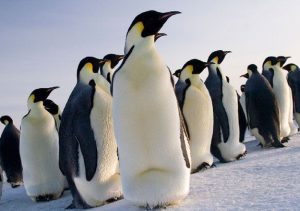Penguins are an interesting species of bird that are found in the southern hemisphere of our planet. There are around 17 different types of penguins, and these species are all non-flying. They have a semi-aquatic lifestyle and several characteristics that are very different than other types of birds we commonly know. While other birds have adapted wings for flying, penguins have adapted flipper-like wings to help them swim through the water.
 A large group of penguins in the water is called a “raft” and a large group on land is called a “waddle.”
A large group of penguins in the water is called a “raft” and a large group on land is called a “waddle.”
A penguin’s body is constructed perfectly for aquatic life. They have long, streamlined bodies that help propel them through the water. They spend around 75-80% of their life in the ocean, but will mate, lay eggs and rest on land. Spending this much time in the water puts penguins at a high risk for predators, such as the leopard seal. Penguins’ wings play an essential role in helping them to escape from predators in the water, but not so much on land. This is because there are several differences between birds that use their wings for flight and our non-flying penguin friends.
Many flying bird’s wings are constructed of delicate, lightweight bones that help to lift the bird off the ground to reach flight. However, some species of birds such as the penguin, ostrich, and emu have heavy solid bones that make it harder for them to stay in the air. A penguin’s wings are designed perfectly however for gliding through water. They are often referred to as flippers because of their shape. The wings are super stiff and penguins can actually rotate them in different directions at the same time! This helps them act as the perfect paddle to help catch their prey. They can even reach speeds of up to 22 mph and some species can hold their breath for as long as 20 minutes!
 A penguin using its wings as flippers to glide through the water!
A penguin using its wings as flippers to glide through the water!
Some scientists believe that a penguin’s inability to fly comes from where they are located. Since penguins have always lived near water millions of years ago, they had to rely upon the ocean for their source of food. Over time they adapted to become more so an aquatic bird, exchanging true wings for “flippers”. Other scientists suggest that getting off the ground took too much effort for a bird that spent so much time in the water. They have over time adapted to their surroundings and decided to become expert swimmers instead of flyers.
Written by: Brooke Fox
References:


